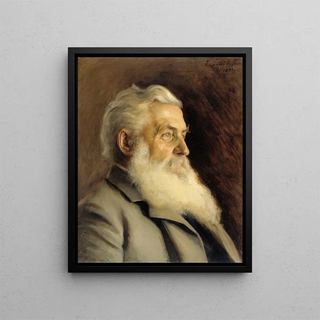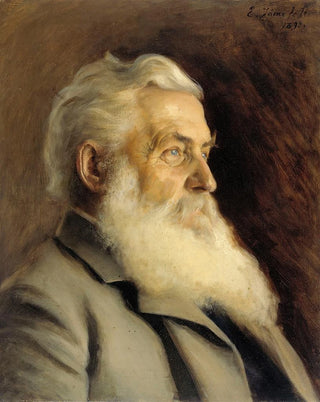Portrait Painting of M. Ahnger - Eero Järnefelt | Art print


View from behind

Frame (optional)
The "Art print of M. Ahnger" by Eero Järnefelt is a work that transcends the simple framework of a pictorial representation. This painting, created at the end of the 19th century, captures not only the appearance of its subject but also the spirit of an era marked by profound social and cultural changes. In this piece, Järnefelt succeeds in evoking an intimate atmosphere, where the viewer is invited to delve into the personal universe of the model. The artist, through his technical skill and keen sense of observation, manages to immortalize subtle emotions, making this portrait a true masterpiece of Finnish painting.
Style and uniqueness of the work
Eero Järnefelt's style in "Art print of M. Ahnger" is imbued with a delicacy that characterizes his approach to portraiture. The chosen colors are both rich and nuanced, creating a visual harmony that immediately draws the eye. Järnefelt plays with light and shadow, using chiaroscuro techniques to add depth to his subject. The texture of the clothing, the finesse of facial features, and the expression in the gaze reveal meticulous attention to detail, demonstrating the artist's commitment to his model. This art print is not limited to a simple physical representation; it also captures M. Ahnger's personality, making the canvas lively and engaging. The composition, carefully balanced, allows the viewer to feel an immediate connection with the subject, making the work all the more captivating.
The artist and his influence
Eero Järnefelt is an emblematic figure of the Finnish artistic movement, and his work is often associated with naturalism and symbolism. Trained at the Helsinki Academy of Fine Arts and having studied in Paris, Järnefelt was able to incorporate various influences to forge his own style. His portraits, such as that of M. Ahnger, demonstrate a deep understanding of human psychology, which allowed him to stand out among his contemporaries. The artist also played a crucial role in the emergence of Finnish painting on the international stage.

Matte finish

View from behind

Frame (optional)
The "Art print of M. Ahnger" by Eero Järnefelt is a work that transcends the simple framework of a pictorial representation. This painting, created at the end of the 19th century, captures not only the appearance of its subject but also the spirit of an era marked by profound social and cultural changes. In this piece, Järnefelt succeeds in evoking an intimate atmosphere, where the viewer is invited to delve into the personal universe of the model. The artist, through his technical skill and keen sense of observation, manages to immortalize subtle emotions, making this portrait a true masterpiece of Finnish painting.
Style and uniqueness of the work
Eero Järnefelt's style in "Art print of M. Ahnger" is imbued with a delicacy that characterizes his approach to portraiture. The chosen colors are both rich and nuanced, creating a visual harmony that immediately draws the eye. Järnefelt plays with light and shadow, using chiaroscuro techniques to add depth to his subject. The texture of the clothing, the finesse of facial features, and the expression in the gaze reveal meticulous attention to detail, demonstrating the artist's commitment to his model. This art print is not limited to a simple physical representation; it also captures M. Ahnger's personality, making the canvas lively and engaging. The composition, carefully balanced, allows the viewer to feel an immediate connection with the subject, making the work all the more captivating.
The artist and his influence
Eero Järnefelt is an emblematic figure of the Finnish artistic movement, and his work is often associated with naturalism and symbolism. Trained at the Helsinki Academy of Fine Arts and having studied in Paris, Järnefelt was able to incorporate various influences to forge his own style. His portraits, such as that of M. Ahnger, demonstrate a deep understanding of human psychology, which allowed him to stand out among his contemporaries. The artist also played a crucial role in the emergence of Finnish painting on the international stage.
12,34 €






